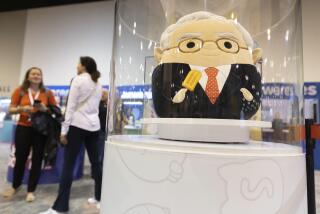Toys R Us says its bankruptcy won’t interrupt the holiday shopping season

Toys R Us was founded in 1957 and pioneered the big-box format for toy sales. (Sept. 19, 2017) (Sign up for our free video newsletter here http://bit.ly/2n6VKPR)
With its spacious, high-ceiling stores that hold thousands of items, Toys R Us pioneered the big-box format for toy sales and became the go-to destination for playthings and baby products — elbowing many smaller toy stores out of business.
Now, Toys R Us Inc. has tumbled into bankruptcy, filing late Monday night for Chapter 11 protection.
But Toys R Us isn’t a simple example of another conventional retailer being steamrolled by consumers’ radical shift to online shopping. Its survival won’t be simple, either.
The retailer said it will keep operating as usual and continue getting toys from suppliers as the crucial holiday shopping season nears, helped by $3 billion in bankruptcy financing. Indeed, the company’s cavernous stores showed no sign Tuesday that the merchant was in trouble.
“It really makes me sad,” said Julian Gonzalez, a United Food & Commercial Workers union representative, outside a Toys R Us in Culver City on Tuesday. “This is where I get most of the toys” for family and friends.
Toys R Us operates 1,695 stores, including its Babies R Us stores; 113 are in California, its largest U.S. market. All told, the Wayne, N.J., company does business in 38 countries.
The company, which employs 65,000, did not announce any store closures and said it planned its normal practice of hiring thousands of additional seasonal workers for the holidays.
But even if Toys R Us gets through the holidays, “they need to do both a financial restructuring as well as an operational restructuring” because Toys R Us “needs to modernize with the times,” said Jeffrey Gleit, a bankruptcy partner with the law firm Sullivan & Worcester.
Toys R Us followed several other retail chains that have sought bankruptcy protection in large part because of the shift to Internet shopping, including shoe chain Payless ShoeSource Inc., children’s clothing seller Gymboree Corp., jeans retailer True Religion Apparel Inc. and electronics seller RadioShack.
Even before the surge of e-commerce, Toys R Us was under pressure from the likes of discount mass merchants Wal-Mart Stores Inc. and Target Corp. that carried a wide selection of toys, often at lower prices.
As online shopping exploded in the last few years, led by e-commerce giant Amazon.com, those mass merchants also bolstered their websites and made shipping faster and less costly. Toys R Us also has a website but it has failed to be as competitive, retail experts said.
Toys R Us further was handcuffed with $5 billion in debt, much of it stemming from 2005 when a trio of investment firms bought the company and took it private. That constrained Toys R Us’ ability to invest further in its stores or website.
With its filing under Chapter 11 of the U.S. Bankruptcy Code, Toys R Us remains open but is protected from creditors’ claims while it works out a court-supervised reorganization plan.
As part of its reorganization, Toys R Us said its lenders agreed to provide the $3 billion in financing needed to reassure suppliers and keep the business running. Toys R Us Chief Executive David Brandon said in a statement that “we expect that the financial constraints that have held us back will be addressed in a lasting and effective way.”
But analysts said the company’s survival will depend on much more than cash.
Toys R Us needs a multi-pronged strategy for improving its store experience, its website and its service while also matching rivals’ prices if it hopes to compete with Amazon and others, said Eric Schiffer, chief executive of the Patriarch Organization, a private equity firm.
Having giant stores with few employees who offer little help “doesn’t cut it anymore,” Schiffer said, adding that “you need to hire people who are oriented about toys, are passionate and well-educated about the products.”
He and others pointed to Best Buy Co. as an example of a big-box retailer that’s managed to stay competitive by matching prices at Amazon and elsewhere online, speeding up shipping times and by bolstering its floor staff with knowledgeable employees.
Brandon Channels, another shopper at the Culver City store, said, “I shop here all of the time for things like ‘Star Wars’ items and DC superheroes and Marvel” and that he would be “very disappointed if they don’t survive.”
But Channels added that he’s quick to compare retailers’ prices on his smartphone and “if I see something for $30 here that I can get for $26 [elsewhere] I’m not going to buy it here.”
The company’s filing came in U.S. Bankruptcy Court for the Eastern District of Virginia in Richmond. Toys R Us said its Canadian unit also intended to seek reorganization in the bankruptcy court in Ontario.
Toys R Us has 259 licensed stores outside of the United States and Canada that it said are not part of the reorganizations.
Toys R Us’ filing was not entirely surprising; there had been rumors for weeks that it might seek bankruptcy protection, and its top executives had warned in recent months that the chain was struggling.
The retailer’s CEO, in a conference call with analysts in June, said there was “very, very aggressive pricing online” that was causing the chain problems.
He also noted that Amazon, Wal-Mart and other online vendors were offering free shipping in many situations and that two-day shipping was becoming commonplace, resulting in “a very difficult quarter” for Toys R Us.
A sales slowdown at Lego Group, one of the leading toy makers, also hurt the toy seller. Earlier this month, Lego said its revenue for the first half of this year fell 5% from a year earlier — its first revenue decline in 13 years.
Toys R Us was “seeing significant weakness in demand for their products globally,” Brandon said in June.
Lego said it would keep working with Toys R Us during its bankruptcy “to ensure an optimal solution is reached” for continued Lego sales and “balancing our commitment to them while responsibly managing our business.”
Hasbro Inc., the maker of Play-Doh and Transformers and My Little Pony toys, said it was declining to comment while it’s “in the process of evaluating the terms of the Toys R Us bankruptcy filing and until we have a full understanding of the terms and their impact to Hasbro.”
A spokesperson for Mattel Inc., which makes Barbie and Hot Wheels, could not immediately be reached for comment.
All three toy makers are among Toys R Us’ largest unsecured creditors, according to the bankruptcy filing. Mattel is owed $135.6 million, Hasbro $59.1 million and Lego $31.6 million.
Toys R Us traces its roots to 1948, when founder Charles Lazarus opened a baby furniture store in Washington. He later began selling toys as well and adopted the Toys R Us name in 1957, with the backward R in the logo to give the impression a child had written it.
By the time Lazarus retired in 1994, the company had grown to more than 1,000 stores.
Toys R Us was taken private in 2005, acquired by the investment firms Bain Capital, KKR & Co. and Vornado Realty Trust in a deal financed mostly with debt. The plan had been to take the company public, but that never happened because of its weak financial performance.
Even if Toys R Us improves its stores, it’s unclear whether it can attract shoppers such as Anita Gould, who stopped at the Culver City store only because she read about its bankruptcy filing and hoped to find some bargains. But she said nothing was marked down.
“It’s just so much easier to go on Amazon and find what you want and then it’s at your door in a day or two, the mother of three said. “Then there’s the added shop-online benefit of not having your children begging for something on every aisle.”
ALSO
How L.A.’s Halo Top became America’s bestselling ice cream pint
With Hulu’s top Emmy win for ‘The Handmaid’s Tale,’ a streaming underdog comes of age
Start-up Bodega learns an important branding lesson; apologizes after Internet outrage
UPDATES:
4:35 p.m.: This article was updated with additional analysis and comments from shoppers.
7:45 a.m.: This article was updated with Toys R Us’ seasonal hiring plans and comments from major toy makers.
6:40 a.m.: This article was updated throughout with Times staff reporting and additional details about Toys R Us’ history, its stores in California and its recent financial problems.
4:10 a.m.: This article was updated with background information.
This article was originally published at 12:15 a.m.








